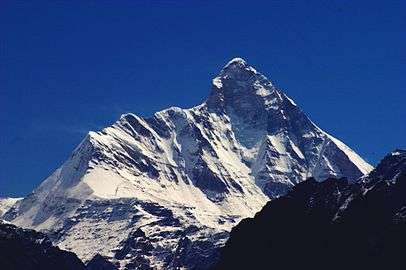Geography of Uttarakhand

Uttarakhand has a total geographic area of 53,483 km², of which 86% is mountainous and 65% is covered by forest.[1] Most of the northern parts of the state are part of Greater Himalaya ranges, covered by the high Himalayan peaks and glaciers, while the lower foothills were densely forested till denuded by the British log merchants and later, after independence, by forest contractors. Recent efforts in reforestation, however, have been successful in restoring the situation to some extent. The unique Himalayan ecosystem plays host to a large number of animals (including bharal, snow leopards, leopards and tigers), plants and rare herbs. Two of India's mightiest rivers, the Ganges and the Yamuna take birth in the glaciers of Uttarakhand, and are fed by myriad lakes, glacial melts and streams in the region.[2]

Terrain and vegetation
Uttarakhand lies on the south slope of the Himalaya range, and the climate and vegetation vary greatly with elevation, from glaciers at the highest elevations to tropical forests at the lower elevations. The highest elevations are covered by ice and bare rock. Mount Nanda Devi is the highest peak of Uttarakhand with the altitude of 7816 m above sea level. Western Himalayan alpine shrub and meadows occur between 3,000 and 5,000 metres (9,800 and 16,400 ft): tundra and alpine meadows cover the highest elevations, Rhododendron-dominated shrublands cover the lower elevations. Western Himalayan subalpine conifer forests lie just below the tree line; at 3,000 to 2,600 metres (9,800 to 8,500 ft) elevation they transition to western Himalayan broadleaf forests, which lie in a belt from 2,600 to 1,500 metres (8,500 to 4,900 ft) elevation. Below 1,500 metres (4,900 ft) elevation lie the Himalayan subtropical pine forests. The drier Terai-Duar savanna and grasslands belt and the Upper Gangetic Plains moist deciduous forests cover the lowlands along the Uttar Pradesh border. This belt is locally known as Bhabar. These lowland forests have mostly been cleared for agriculture, but a few pockets remain.[3]
National parks
Indian National Parks in Uttarakhand include the Jim Corbett National Park (the oldest national park of India) at Ramnagar in Nainital District, Valley of Flowers National Park and Nanda Devi National Park in Chamoli District, which together are a UNESCO World Heritage Site, Rajaji National Park in Haridwar District, and Govind Pashu Vihar National Park and Gangotri National Park in Uttarkashi District.